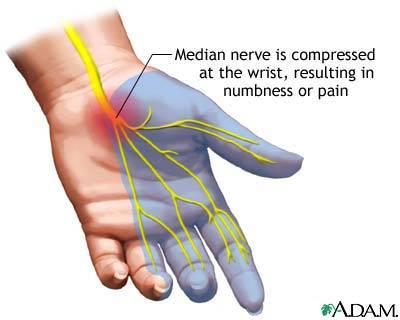Carpal tunnel syndrome

Carpal tunnel syndrome is a disease of the hand characterized by numbness, tingling, pain , and weakness. The disease typically affects the thumb, index, and middle fingers and is often particularly troublesome at night. A major nerve, specifically the median nerve, travels down the arm and enters the hand through the carpal tunnel, which is located in the central part of the wrist. In people with carpal tunnel syndrome, pressure in the carpal tunnel is higher than in unaffected people, and median nerve irritation occurs.Many conditions can cause increased pressure within the carpal tunnel and lead to carpal tunnel syndrome. Carpal tunnel syndrome was first described with broken wrists. A broken wrist can cause bleeding and swelling within the carpal tunnel leading to increased pressure within the carpal tunnel. Most people with carpal tunnel syndrome have no identifiable cause. It affects almost 5% of the population and is most common in middle-aged women. Carpal tunnel syndrome is diagnosed based on the complaints of the individual combined with physical tests and often electrical studies. No single test is definitive for diagnosis of carpal tunnel syndrome. Instead, the person's complaints and test findings together lead to its diagnosis.







